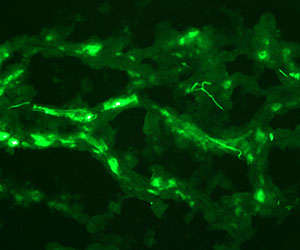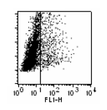TLR8 Mouse Monoclonal Antibody [Clone ID: 303F1.14]
Specifications
| Product Data | |
| Clone Name | 303F1.14 |
| Applications | WB |
| Recommended Dilution | DDX0480P-50 / DDX0480P-100 Purified: WB, IHC frozen section, intra FC DDX0480A488-50 / DDX0480A488-100 Alexa-fluor®488: IF, intra Flow Cytometry DDX0480A546-50 / DDX0480A546-100 Alexa-fluor®546: IF DDX0480A647-50 / DDX0480A647-100 Alexa-fluor®647: intra Flow Cytometry DDX0480B-50 / DDX0480B-100 Biotin: WB. Usage recommendation: *This monoclonal antibody may be used between 1-10 μg/ml. *Optimal dilution should be determined by each laboratory for each application. *Coupled antibody: to maintain RT before using. |
| Reactivities | Human |
| Host | Mouse |
| Isotype | IgG2a |
| Clonality | Monoclonal |
| Immunogen | Human recombinant TLR8. |
| Specificity | Human TLR8. Negative on Mouse, Rat. |
| Formulation | Purified: 100 μg in 200μl / 50 μg in 100 μl Tris-NaCl pH 8. Coupled: 100 μg in 200μl / 50 μg in 100 μl Tris PBS 50% glycerol. Label: Biotin |
| Concentration | lot specific |
| Purification | QMA Hyper D ion exchange chromatography |
| Conjugation | Biotin |
| Storage | -20°C. KEEP CONTENTS STERILE: no preservative. Purified antibodies: avoid repeated freeze/thaw cycles. Coupled antibodies: glycerol protects from freezing. |
| Gene Name | toll like receptor 8 |
| Database Link | |
| Background | The Toll-Like Receptors (TLRs) represent a family of germline-encoded proteins, composed of C-terminal leucine-rich repeats (LRRs), and an N-terminal Toll/Interleukin-1 Receptor (TIR) domain. In humans, 10 TLRs, sharing high sequence homology, have been identified. TLRs are critical for the detection of pathogen-associated molecular patterns (PAMPs) by the innate immune system. LRRs recognize PAMPs, and signal transduction events, initiated by the TIR domain, lead to activation of transcription factors such as AP-1, IRFs and NFkB, and therefore expression of proinflammatory cytokines and costimulatory molecules. TLR7, TLR8 and TLR9 form a subgroup in the TLR family, because of a strong sequence homology and the nature of their ligands, which are nucleic acids or related molecules. TLR7 and TLR8 are triggered by GU-rich, single-stranded RNA (ssRNA) derived from viruses, or by synthetic small molecules mimicking ssRNA, such as imidazoquinolines. While TLR7 is expressed in lung, placenta and spleen, TLR8 expression is restricted to lung and peripheral blood leukocytes (PBLs). Heil F. et al,2003 ,Eur.J.Immunol, 33, 2987) |
| Synonyms | Toll-like receptor 8, UNQ249/PRO286 |
| Reference Data | |
Documents
| Product Manuals |
| FAQs |
{0} Product Review(s)
0 Product Review(s)
Submit review
Be the first one to submit a review
Product Citations
*Delivery time may vary from web posted schedule. Occasional delays may occur due to unforeseen
complexities in the preparation of your product. International customers may expect an additional 1-2 weeks
in shipping.






























































































































































































































































 Germany
Germany
 Japan
Japan
 United Kingdom
United Kingdom
 China
China








